
Architectural Styles and Revivals: The Exotic Revival
(written by Dr. Les Crocker, UWL Emeritus Professor of Art History)
In the book A Field Guide to American Houses by Virginia & Lee McAlester, the authors group what they call “subunits”, or types of ornamentation added onto Romantic era homes, into a single movement called "Exotic Revivals." The types of ornamentation were inspired by architecture from regions that western cultures like the U.S. considered "exotic" because of the imperialistic mindset during the 1800s-1900s. Today, this label prevails thanks to the lasting impacts of colonialism, but in this blog, I tried to identify specific cultures and the legacy of colonialism as much as possible.
La Crosse never had much in the way of buildings inspired by Middle Eastern or Asian architecture, but then the Exotic Revivals were uncommon overall. There were just a handful of structures that used some of these architectural elements.
In these blogs I have tried to use examples that you can still visit, but some exceptional buildings that have been destroyed deserve to be recorded and remembered. Similarly, I wanted to discuss styles in terms of houses, but, again, the extraordinary in commercial buildings should be noted.
Egyptian Revival
Napoleon invaded Egypt in 1798 over trade issues but the real significance of the campaign came from a multi-volume work that was issued in 1809-22. With 900 colored engravings of Egyptian tombs, temples and paintings, the Description de L'Egypte was the first significant view into the world of ancient Egypt by Europeans. Due to conflicts with the Turkish rulers of Egypt, few Europeans had traveled there for over a thousand years.
Napoleon's publication provided the material for the Egyptian revival, but the style never quite caught on with the public. The discovery of King Tut's tomb in 1922 caused a second Egyptian Revival, but that was almost entirely in the decorative arts.
Second County Jail, 1859 Demolished
There was an Egyptian Revival jail built in 1859 with battered walls, wider at the bottom than the top, and a rolled cornice. The one photo of the building that I have seen does not show much detail.
It was the most solid building in town and even in its simplicity it was far more elaborate than any city building until the 1880s.

This jailhouse built in 1859 featured elements inspired by Egyptian architecture. Photo from Tenney & Elmer stereoview in LPL Archives collection.
Moorish Revival
Hixon House, 429 N. 7th St. The Hixon's Turkish nook, 1900-01.
Ellen Hixon took her own trip to Egypt and Turkey for a period of nine months from December 1898 until September 1899. When she got home, she had the Chicago architect G.L. Harvey, who was already in La Crosse working on the design for a new hospital, to design her nook as part of the 1900-01 house renovation. The interior decoration was done by Joseph Twyman, chief of the Department of Decoration for the Tobey Furniture Company of Chicago, and a student of William Morris.
Beyond the living room and before the dining room is the Turkish nook, often called a Turkish corner. There never had been any Turkish influenced buildings in La Crosse, that I know of, and the Hixon's nook is the only Turkish interior that was built. Nationwide they are very rare. It is truly a unique space.
A hexagonal table of blue with black and white inlay support displays a ceramic set for serving chocolate with. A divan, the traditional seating in parts of the Middle East, has become a built-in banquette, but covered in fabric with a non-European design and a rug of similar design. There is a wooden mashrabiya screen (sometimes called a harem screen) that originally would have been used to shade street-facing windows from the desert heat.
On the west wall is collection of Turkish military items: a helmet with chain mail to protect the neck, a round, convex shield, several battle axes, swords, a dagger, and an arrow, all organized into a peaceful decoration. You didn't have to fight the Turks to get such souvenirs; they were available by mail order from various companies selling exotica or from a furniture company in Chicago.
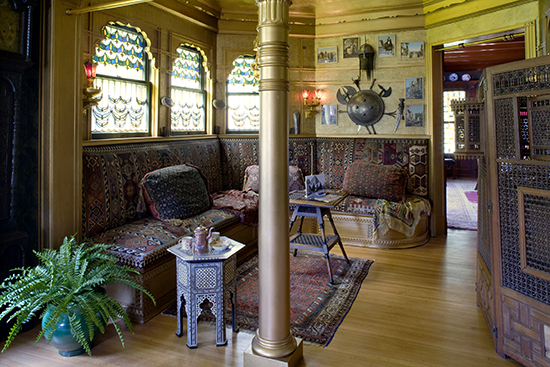
The Turkish Nook in the Hixon House; one of only two such spaces left in Wisconsin. Photo courtesy of Roger Grant.
Margaret Lichter of the La Crosse County Historical Society created a video all about the Nook.
Galena House/Palm Garden Saloon, 115 N. Front St. Demolished, ca. 1969.
Probably the most surprising interior in the city could be found at what is thought to be the Galena House at 115 N. Front St. from 1870 to 1900. In 1900 it became the Palm Garden Saloon.

A view of some of the buildings on the west side of Front Street between Main and State Streets. The Galena House/Palm Garden Saloon once occupied the white building advertising Hamm’s beer.
This photo is probably from 1969, just prior to the demolition of Front Street and one side of Second Street; done as part of the Harborview Plaza development project, the most destructive event in the architectural history of La Crosse. By this time the building was vacant, the last known occupant was the Old Style Inn; painted lettering on the windows and a Hamm’s beer sign are the only clues to that. Most of the buildings along both sides of Front, especially the older two-story ones, had suffered greatly from lack of maintenance. Third Street and farther east had become the newer commercial center as the town grew east from the river.
The rear, the white building in this 1969 photo, faced the river. This photo shows a one story with basement frame addition to the original two-story brick building.

The rather peculiar conical "hat" suggests that the building was not always as derelict as it had become by 1969.
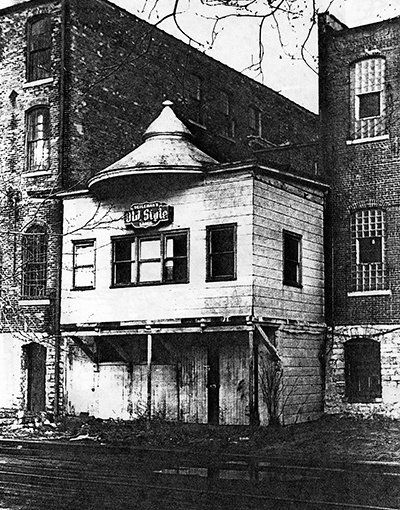
A closer back view of the Palm Garden Saloon. 1967 photo by the author.
The following photos show an interior influenced by the Moorish Revival. They are undated, but I think they are from the 1890s; probably a remodeling that the owner Charles Donoghoe wanted to show off. The recurve arches with hanging pendants, probably made with plaster, would certainly qualify as Turkish in the minds of the saloon patrons of the late nineteenth century. The painted decoration on the arches does resemble decorative forms used in some Islamic mosques. The Moorish Revival purported to be from the Middle East. It was a curiosity, brief fad, rather than a style.
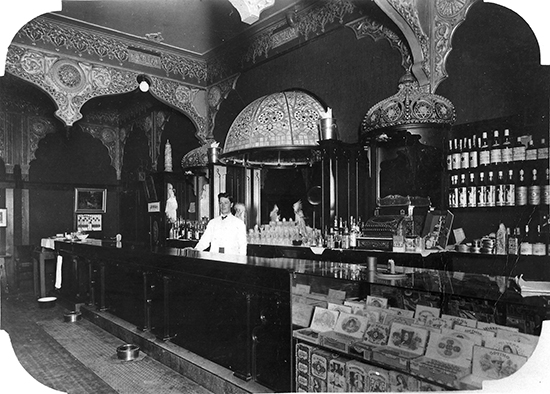
A large half dome of stained glass is over the center of the back bar, flanked by two smaller, even more complex half domes. These half domes would have been gorgeous in the low light of the bar.
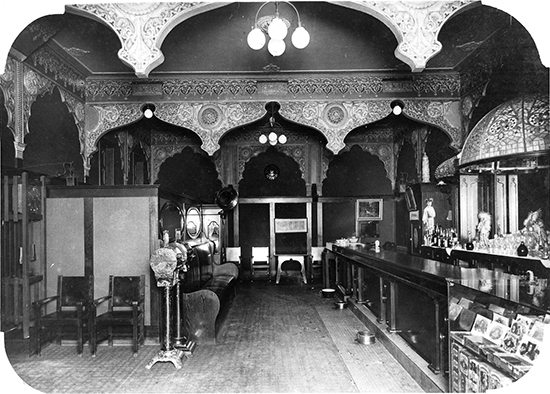
The hanging globes indicate the saloon was wired for electricity.
However, there is some question about whether these two photos are from the Galena House. The only certain images we have are from the 1900 remodeling of the bar into the Bismark Palm Garden by Herman Noll, who was also the proprietor of the Log Cabin Saloon in 1903.
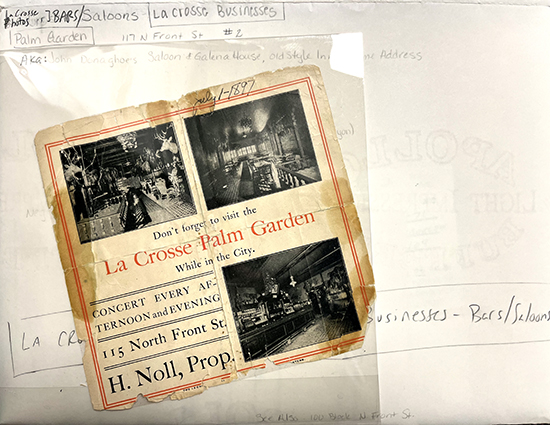
An advertising card shows off the inside of the Palm Garden. Materials found at UW-La Crosse Murphy Library Special Collections.
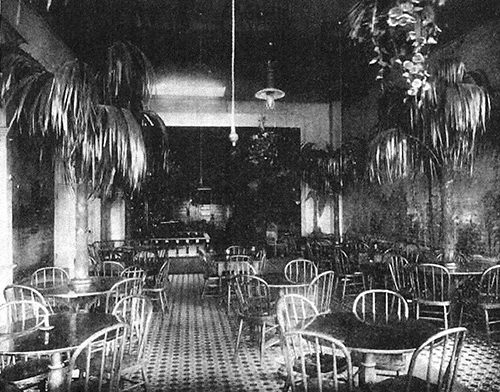
The walls of the Palm Garden were festooned with faux palm trees.
Pettibone Park Pavilion, Pettibone Island. Built: 1901
The Pettibone Park Pavilion built in 1901 to the designs of Schick & Roth, the major architectural firm in La Crosse at that time, is sometimes considered "Islamic" or "Moorish," neither term very informative or descriptive. Mostly, I think it's the eight-sided pointed arch dome that people find exotic. Octagonal buildings are rare in architecture throughout the world. The Romans used some octagonal rooms and short octagonal towers were often incorporated into fortress walls. Bell towers were sometimes octagonal in the post Roman world. There are some octagonal Christian churches in the Middle East but I would not associate an octagonal plan with the Islamic religion or culture. Another instance of a name being an identifier, not a descriptor. (For more on octagonal buildings in La Crosse see my blog, The Octagonal Mystery.)
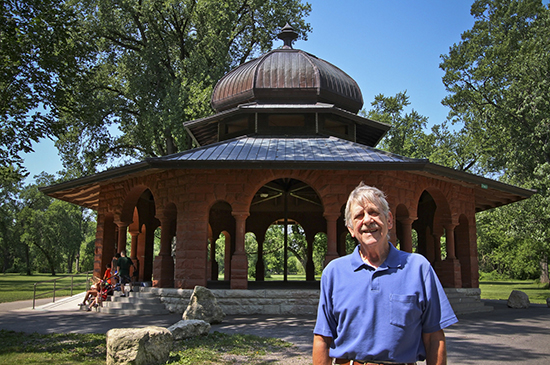
The author in front of the Pettibone Park Pavilion. 2012 photo by Sue Lee.
The stone 'walls' that support the roof are Roman- and Renaissance-inspired rather than Middle Eastern. The eight corners are rusticated, rough-surfaced, stone and the same stone is used for the pedestals beneath the columns. The columns are not classical in proportion or decoration, they are somewhat generic columns. The two columns on each of the eight sides carry the weight of the tall central arch and the narrow flanking arches. Often called a Palladian entrance or window, depending on its placement, the tall central unit flanked by smaller units that are half the width of the central unit was used by the Italian architect Andrea Palladio in several of his buildings and widely spread by use in his book The Four Books of Architecture, first published in 1570, and republished in many editions and several languages. Palladio revived the form from fifteen hundred years earlier as it was a variation of the Roman Triumphal Arch discussed in the Greek and Roman styles blog. When done well the three-part unit is quite satisfying to the eye and mind.
Though the Exotic Revivals were rare in the U.S. to begin with, it is notable that they were represented in La Crosse in some fashion and that we have some proof that they existed. Around the same time that they emerged, another style would also gain popularity, but it would turn out to be more than a just a passing fad in this area.
Other entries in this series
Architectural Styles and Revivals
Architectural Styles and Revivals: The Greek and Roman Revivals
Architectural Styles and Revivals: The Gothic Revival
Architectural Styles and Revivals: The Italianate Style
Architectural Styles and Revivals: The Second Empire Style
Architectural Styles and Revivals: The Queen Anne Style
Architectural Styles and Revivals: The Colonial Revival
Architectural Styles and Revivals: Romanesque Revival Public Buildings
Architectural Styles and Revivals: Romanesque Revival Commercial Buildings
Architectural Styles and Revivals: Romanesque Revival Homes
Architectural Styles and Revivals: Religious Romanesque
